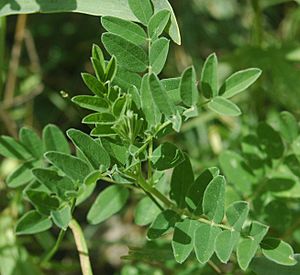Mongolian milkvetch facts for kids
Quick facts for kids Mongolian milkvetch |
|
|---|---|
 |
|
| Scientific classification | |
| Synonyms | |
|
Astragalus mongholicus, also known as Mongolian milkvetch, is a type of flowering plant. It belongs to the Fabaceae family, which is also called the pea family. This plant has a few other scientific names, like Astragalus propinquus and Astragalus membranaceus.
In Mongolia, it is known as 'Хунчир'. In China, it is called huáng qí (Chinese: 黃芪), běi qí (Chinese: 北芪) or huáng huā huáng qí (Chinese: 黃花黃耆). It is a perennial plant, which means it lives for more than two years. Astragalus mongholicus is important in traditional Mongolian medicine. It is not currently considered an endangered plant.
Contents
Where Does Mongolian Milkvetch Grow?
Astragalus mongholicus is found across many parts of Asia. You can find it in countries like Kazakhstan and Mongolia. It also grows in Siberia and the Russian Far East. This plant is common in western and northern China.
How Mongolian Milkvetch is Used
This plant is used in traditional Chinese medicine (TCM). People have used it for a long time. It is one of the 50 most important herbs in traditional Mongolian medicine.
Sometimes, Astragalus mongholicus is part of food supplements. For example, it is in a product called Lectranal. This supplement is sometimes used to help with seasonal allergic rhinitis, which is like hay fever. However, there is not much scientific proof yet that it works well for this.
What's Inside the Plant?
The roots of Astragalus mongholicus contain many interesting natural chemicals. These include:
- Polysaccharides: These are types of complex sugars.
- Triterpenoids: Such as chemicals called astragalosides.
- Isoflavones: These include kumatakenin, calycosin, and formononetin.
- Other related compounds: Like glycosides and malonates.
- A special compound: It also contains a saponin called cycloastragenol.
These chemicals are what make the plant useful in traditional medicine.
Is It Safe to Use?
Some other types of Astragalus plants can be harmful. They might cause problems for farm animals. This is because those plants can have certain chemicals. These chemicals include indolizine alkaloids and nitro compounds. Some can also collect a lot of selenium.
However, scientists have checked Astragalus mongholicus. They have not found these harmful chemicals in the plant. This is good news for its use in dietary supplements and traditional medicine.
Official Recognition
Astragalus mongholicus is listed in official books of medicines. These books are called pharmacopoeia. It is listed there under its other name, A. propinquus.
- It is included in the Japanese Pharmacopoeia. This means it is recognized as a medicinal plant in Japan.
See also
 In Spanish: Huáng qí para niños
In Spanish: Huáng qí para niños
- Tremella fuciformis

